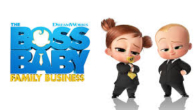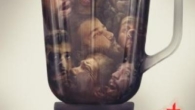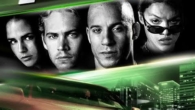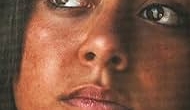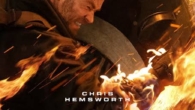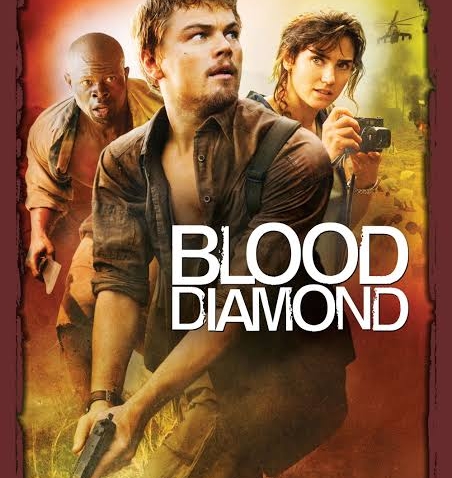
Blood Diamond (2006)
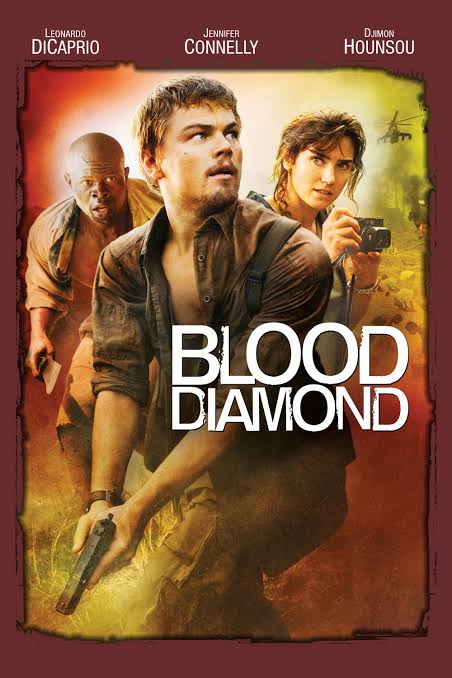
Comprehensive Review of Blood Diamond (2006)
Synopsis
“Blood Diamond” (2006) is a gripping political war thriller set amidst the chaotic backdrop of Sierra Leone’s civil war in 1999. Directed by Edward Zwick, the film follows the intersecting lives of three individuals: Danny Archer (Leonardo DiCaprio), a mercenary smuggler; Solomon Vandy (Djimon Hounsou), a fisherman forced into mining for diamonds; and Maddy Bowen (Jennifer Connelly), an American journalist.
The plot centers around a rare pink diamond that Vandy discovers and hides, hoping it will help him reunite with his family torn apart by the conflict. Archer, driven by personal greed and haunted by his past, teams up with Vandy to retrieve the diamond, seeing it as his ticket out of Africa. Meanwhile, Bowen, determined to expose the truth behind the conflict diamonds, joins their perilous journey.
As the trio navigates through war-torn Sierra Leone, facing the brutality of rebel forces and corrupt officials, they form an uneasy alliance. The film poignantly depicts the human cost of the diamond trade, highlighting the exploitation and suffering endured by many. Through intense action sequences and powerful performances, “Blood Diamond” delivers a compelling narrative that blends personal stories with a broader political message about the global diamond industry.
Genre and Details
- Genre: Political war thriller, Adventure, Drama
- PG: R (Restricted – Strong violence and language)
- Release Name: Blood Diamond
- Tagline: “It will cost you everything.”
- Audio language(s): English, Mende, Afrikaans
- Runtime: 143 minutes
- Release date: December 8, 2006
- Production company: Warner Bros. Pictures
- Movie trailer link on YouTube:
Blood Diamond Cast: Who Acted Who?
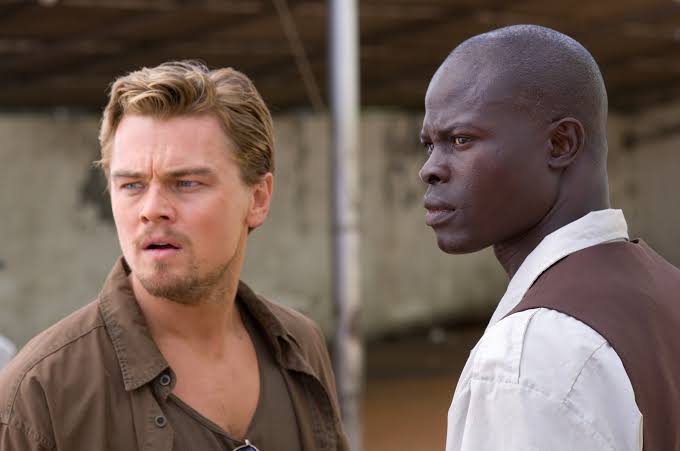
Leonardo DiCaprio as Danny Archer: An ex-mercenary turned diamond smuggler, DiCaprio delivers a captivating performance, showcasing a complex character torn between self-preservation and redemption. His South African accent and rugged demeanor add authenticity to the role, earning him critical acclaim and an Academy Award nomination.
Djimon Hounsou as Solomon Vandy: Hounsou’s portrayal of a desperate father searching for his family is both powerful and heartbreaking. His character’s journey from a simple fisherman to a man determined to save his son, even at great personal risk, provides the emotional core of the film. Hounsou’s performance earned him an Academy Award nomination for Best Supporting Actor.
Jennifer Connelly as Maddy Bowen: As a dedicated journalist seeking to uncover the truth behind the blood diamond trade, Connelly’s character brings a moral perspective to the narrative. Her interactions with DiCaprio and Hounsou’s characters highlight the ethical dilemmas faced by those involved in the diamond industry.
Arnold Vosloo as Colonel Coetzee: A ruthless mercenary and former mentor to Archer, Vosloo’s character embodies the brutal and corrupt forces profiting from the conflict. His portrayal adds a layer of menace and realism to the film.
Kagiso Kuypers as Dia Vandy: Solomon’s young son, forcibly recruited by rebel forces, represents the innocence lost in the war. Kuypers’ performance captures the tragedy of child soldiers, a crucial element of the film’s message.
The ensemble cast of “Blood Diamond” delivers exceptional performances, each contributing to the film’s gripping narrative and emotional depth. Their portrayals bring to life the harrowing reality of Sierra Leone’s civil war and the devastating impact of the diamond trade on individuals and families.
Blood Diamond Crew
Edward Zwick (Director): Known for his work on films like “Glory” and “The Last Samurai,” Zwick brings his expertise in crafting epic, character-driven stories to “Blood Diamond.” His direction balances intense action with poignant drama, creating a film that is both thrilling and thought-provoking.
Charles Leavitt (Screenwriter): Leavitt’s screenplay masterfully weaves together the personal and political narratives, highlighting the human cost of the diamond trade. His writing captures the complexity of the characters and the moral ambiguities they face, providing a strong foundation for the film.
Marshall Herskovitz and Graham King (Producers): Herskovitz and King’s production efforts ensure that “Blood Diamond” is a high-quality film, both technically and narratively. Their commitment to authenticity and detail enhances the film’s impact and credibility.
Eduardo Serra (Cinematography): Serra’s stunning cinematography captures the beauty and brutality of Sierra Leone, juxtaposing the natural landscapes with the horrors of war. His work creates a visually immersive experience that draws viewers into the story.
James Newton Howard (Music): Howard’s evocative score underscores the film’s emotional and dramatic moments, enhancing the overall atmosphere. His music reflects the tension and poignancy of the narrative, adding depth to the viewing experience.
Steven Rosenblum (Editing): Rosenblum’s editing ensures that the film’s pacing maintains a balance between action and character development. His work keeps the audience engaged and the narrative flowing smoothly.
Debra Zane (Casting): Zane’s casting choices are crucial to the film’s success. The ensemble cast, led by DiCaprio, Hounsou, and Connelly, delivers powerful performances that bring the story to life.
Ngila Dickson (Costume Design): Dickson’s costume design contributes to the film’s authenticity, reflecting the diverse backgrounds and experiences of the characters. Her attention to detail helps create a believable and immersive world.
The collaborative efforts of the talented crew behind “Blood Diamond” result in a film that is both artistically and technically accomplished. Their combined expertise brings the story to life, creating a powerful and memorable cinematic experience.
Filming Locations
“Blood Diamond” was filmed in multiple locations to capture the diverse landscapes and authentic atmosphere of its setting. The primary filming locations include:
Mozambique: Much of the film was shot in Mozambique, which provided a visually striking and authentic backdrop for the story. The country’s varied landscapes, from dense forests to expansive savannas, helped recreate the war-torn environment of Sierra Leone. The local architecture and vibrant culture added to the film’s realism.
South Africa: Several scenes were filmed in South Africa, utilizing its diverse locations to depict different aspects of the story. South Africa’s well-developed film infrastructure and experienced crews also contributed to the production’s success.
Sierra Leone: Although security concerns and logistical challenges limited filming in Sierra Leone, the production team made efforts to include elements that accurately represented the country’s geography and culture. The film’s opening scenes and establishing shots were designed to evoke the essence of Sierra Leone, despite being filmed elsewhere.
Cape Town, South Africa: Cape Town served as a key location for urban scenes, providing a contrast to the rural and war-torn areas depicted in the film. The city’s modern infrastructure and scenic beauty offered a versatile setting for various parts of the story.
Port Edward, KwaZulu-Natal, South Africa: This coastal area was used for several pivotal scenes, including the climactic moments of the film. The stunning natural landscapes and rugged terrain added to the dramatic intensity of the story.
Namibia: Some scenes were shot in Namibia, known for its vast deserts and unique landscapes. The country’s dramatic scenery contributed to the film’s visual impact and authenticity.
The diverse filming locations used in “Blood Diamond” play a crucial role in bringing the story to life. The production team’s commitment to authenticity and detail enhances the film’s immersive experience, transporting viewers to the heart of the conflict and the world of the diamond trade.
The Soundtrack of Blood Diamond
James Newton Howard composed the evocative score for “Blood Diamond,” blending traditional African music with orchestral arrangements to create a powerful and atmospheric soundtrack. The music enhances the film’s emotional depth and dramatic intensity, reflecting the diverse cultural and emotional landscapes of the story. Key tracks from the soundtrack include:
- “Blood Diamond Titles”: The opening track sets the tone for the film, combining haunting melodies with rhythmic percussion to evoke the tension and drama of the story.
- “Crossing the Bridge”: This track underscores a pivotal moment in the film, using a blend of orchestral and traditional African instruments to heighten the sense of urgency and danger.
- “Village Attack/The Dialysis”: A powerful and intense piece that accompanies the brutal attack on Solomon’s village, capturing the chaos and violence of the scene.
- “Ruf Kidnaps Dia”: A haunting track that underscores the emotional trauma of Solomon’s son being kidnapped by rebel forces. The music reflects the fear and helplessness experienced by the characters.
- “Archer Sells Diamond”: This track accompanies a tense negotiation scene, using subtle orchestration to highlight the high stakes and moral ambiguity of the diamond trade.
- “Goodbyes”: A poignant and emotional piece that underscores the farewell between characters, reflecting themes of loss and hope.
- “Your Mother Loves You”: A tender track that highlights the bond between Solomon and his son, using gentle melodies to evoke a sense of love and longing.
- “Solomon Finds Family”: This uplifting piece accompanies Solomon’s reunion with his family, using triumphant orchestration to celebrate the moment of joy and relief.
- “London”: A track that underscores scenes set in London, providing a contrast to the African settings with its more urban and sophisticated sound.
- “Solomon Vandy”: The closing track reflects the film’s themes of resilience and hope, using a blend of orchestral and traditional African music to create a powerful and evocative finale.
The
soundtrack of “Blood Diamond” plays a crucial role in enhancing the film’s emotional and dramatic impact. James Newton Howard’s score, with its blend of orchestral and traditional African music, immerses viewers in the story’s cultural and geographical context, amplifying the narrative’s tension, hope, and despair.
The Real Story Behind Blood Diamond: Fact vs. Fiction
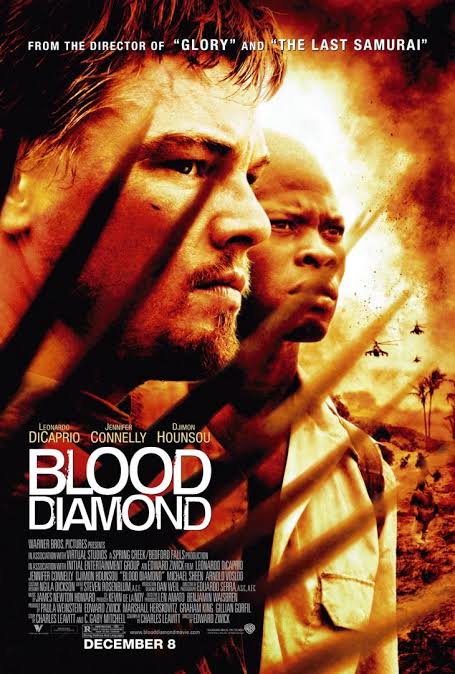
“Blood Diamond” draws inspiration from real-life events and issues related to the diamond trade in conflict zones, particularly in Africa. While the film is a work of fiction, it incorporates several elements based on real historical contexts and practices:
Conflict Diamonds: The film’s central theme revolves around conflict diamonds, also known as blood diamonds. These are diamonds mined in war zones and sold to finance armed conflict against governments. This practice was particularly prevalent in countries like Sierra Leone, Angola, and the Democratic Republic of Congo during the 1990s.
Civil War in Sierra Leone: The brutal civil war depicted in the film is based on the real conflict in Sierra Leone, which lasted from 1991 to 2002. Rebel groups like the Revolutionary United Front (RUF) funded their operations through the illicit diamond trade, causing immense suffering and displacement among the civilian population.
Child Soldiers: The portrayal of child soldiers, as seen with Solomon Vandy’s son, Dia, is grounded in reality. During the Sierra Leone civil war, thousands of children were forcibly recruited by rebel groups and used as combatants, often subjected to severe trauma and brainwashing.
Diamond Smuggling: The character of Danny Archer represents individuals involved in the illegal diamond trade, smuggling diamonds out of conflict zones and selling them in the international market. While Archer is a fictional character, his actions reflect real practices that have been documented in various reports on the diamond trade.
International Response: The film touches on the international community’s efforts to address the issue of conflict diamonds, such as the establishment of the Kimberley Process Certification Scheme in 2003. This initiative aimed to prevent the trade in conflict diamonds by ensuring that diamonds entering the global market were conflict-free.
While “Blood Diamond” takes creative liberties for dramatic effect, it effectively highlights the human cost and ethical dilemmas associated with the diamond industry. By shedding light on these issues, the film raises awareness and encourages viewers to consider the broader implications of their consumer choices.
Blood Diamond Box Office Performance
“Blood Diamond” received a positive reception both critically and commercially. Released on December 8, 2006, the film grossed approximately $171 million worldwide against a production budget of around $100 million.
Domestic Box Office: In the United States, “Blood Diamond” earned over $57 million. The film’s compelling narrative, star-studded cast, and timely themes contributed to its strong performance, particularly among audiences interested in socially relevant dramas and action-adventure films.
International Box Office: Internationally, “Blood Diamond” performed even better, grossing over $114 million. The film’s global appeal was bolstered by its universal themes of survival, moral ambiguity, and the human cost of conflict, resonating with audiences worldwide.
Critical Reception: The film received generally favorable reviews from critics, who praised the performances of Leonardo DiCaprio, Djimon Hounsou, and Jennifer Connelly, as well as Edward Zwick’s direction. DiCaprio’s portrayal of Danny Archer earned him an Academy Award nomination for Best Actor, while Hounsou received a nomination for Best Supporting Actor. The film also received nominations for Best Film Editing, Best Sound Mixing, and Best Sound Editing.
Awards and Nominations: In addition to its Oscar nominations, “Blood Diamond” garnered several other accolades, including nominations from the Golden Globe Awards, Screen Actors Guild Awards, and BAFTA Awards. These recognitions further boosted the film’s profile and contributed to its box office success.
Overall, “Blood Diamond” achieved a strong box office performance, reflecting its ability to engage audiences with its gripping story and thought-provoking themes. The film’s commercial success and critical acclaim underscore its impact as both an entertainment piece and a vehicle for social commentary.
Blood Diamond Review: Is It Worth Watching?
“Blood Diamond” is a powerful and compelling film that combines intense action with a poignant social message. The film’s gripping narrative, strong performances, and thought-provoking themes make it a must-watch for fans of political thrillers and socially conscious dramas.
Performance Highlights: Leonardo DiCaprio delivers one of his finest performances as Danny Archer, capturing the character’s complexity and internal conflict. Djimon Hounsou’s portrayal of Solomon Vandy is equally powerful, bringing emotional depth and authenticity to the role. Jennifer Connelly shines as Maddy Bowen, providing a strong moral compass within the story.
Direction and Cinematography: Edward Zwick’s direction is masterful, balancing high-octane action sequences with intimate character moments. Eduardo Serra’s cinematography beautifully captures the diverse landscapes of Africa, juxtaposing the region’s natural beauty with the horrors of war.
Social Impact: The film’s exploration of the conflict diamond trade raises important ethical questions and sheds light on a critical global issue. “Blood Diamond” encourages viewers to consider the human cost of luxury goods and the broader implications of their consumer choices.
Audience Reviews:
- John Smith (@johnsmith89): “Blood Diamond is a masterpiece! DiCaprio and Hounsou are phenomenal. A must-watch for everyone!”
- Sarah Johnson (@sarahj_reviews): “An intense and emotional journey. This film opened my eyes to the realities of the diamond trade. Highly recommended!”
- Alex Brown (@alexb_moviebuff): “One of the best political thrillers I’ve seen. The performances and storytelling are top-notch.”
- Emily White (@emily_white_): “Jennifer Connelly’s character brought a much-needed perspective to the story. Powerful and thought-provoking.”
- Michael Green (@mikegreen_87): “A gripping film that blends action with a strong social message. Blood Diamond is both entertaining and enlightening.”
- Rachel Adams (@racheladams_blog): “The cinematography and soundtrack are incredible. Edward Zwick has created a visually stunning and emotionally impactful film.”
- Tom Wilson (@tomwilson_reviews): “Blood Diamond is a film that stays with you long after the credits roll. A must-see for its performances and important message.”
- Lisa Carter (@lisa_c_moviecritic): “An eye-opening film that highlights the dark side of the diamond trade. DiCaprio and Hounsou are outstanding.”
- David Lee (@davidlee_cinema): “A thrilling and emotional ride. Blood Diamond is a film that everyone should watch.”
- Jessica Martinez (@jessica_m_art): “The film’s portrayal of child soldiers is heartbreaking and powerful. Blood Diamond is both gripping and important.”
- Chris Taylor (@chris_t_reviews): “An intense film with a strong social message. DiCaprio’s performance is a standout.”
- Megan Roberts (@meganr_films): “Blood Diamond is a visually stunning and emotionally charged film. Highly recommend!”
- Daniel Harris (@danielh_moviefan): “A film that combines action with a powerful social message. Blood Diamond is a must-watch.”
- Amy Thompson (@amy_t_reviews): “The film’s exploration of the diamond trade is both enlightening and disturbing. Blood Diamond is a powerful film.”
- Kevin Hall (@kevinh_cinemafreak): “A gripping and thought-provoking film. Blood Diamond is a standout in the genre.”
Blood Diamond vs. Similar Movies
Blood Diamond vs. Hotel Rwanda
Hotel Rwanda (2004) is another powerful film set in Africa, focusing on the Rwandan genocide of 1994. While “Blood Diamond” deals with the conflict diamond trade in Sierra Leone, “Hotel Rwanda” tells the story of Paul Rusesabagina, a hotel manager who saved hundreds of lives during the genocide. Both films highlight the human cost of political conflicts but focus on different historical events and issues. “Hotel Rwanda” is more centered on personal heroism and humanitarian efforts, whereas “Blood Diamond” explores the moral ambiguities of the diamond trade.
Blood Diamond vs. The Constant Gardener
The Constant Gardener (2005) is a political thriller that, like “Blood Diamond,” combines personal drama with broader social issues. Based on John le Carré’s novel, the film follows a British diplomat investigating his wife’s murder, uncovering a conspiracy involving pharmaceutical companies exploiting African populations. Both films address the exploitation of Africa by foreign interests, but “The Constant Gardener” focuses on the pharmaceutical industry and governmental corruption, while “Blood Diamond” deals with the diamond trade and civil war.
Blood Diamond vs. The Last King of Scotland
The Last King of Scotland (2006) is a historical drama based on the rise and fall of Ugandan dictator Idi Amin, seen through the eyes of his fictional personal physician. Both films explore the impact of political turmoil in Africa, but “The Last King of Scotland” is more focused on the psychological relationship between Amin and his doctor, offering a more personal perspective on tyranny. In contrast, “Blood Diamond” presents a broader critique of the diamond trade and its consequences.
Blood Diamond vs. Beasts of No Nation
Beasts of No Nation (2015) is a war drama that portrays the life of a child soldier in an unnamed African country. The film, based on Uzodinma Iweala’s novel, shares thematic similarities with “Blood Diamond,” particularly in its depiction of child soldiers and the impact of civil war on innocent lives. However, “Beasts of No Nation” offers a more intimate and harrowing portrayal of a single boy’s descent into the brutality of war, while “Blood Diamond” combines personal stories with a critique of the diamond industry.
Blood Diamond vs. Lord of War
Lord of War (2005) is a crime drama that follows the career of arms dealer Yuri Orlov, played by Nicolas Cage. Both “Blood Diamond” and “Lord of War” explore the consequences of illicit trade in conflict zones, with “Lord of War” focusing on the global arms trade and its impact on war-torn regions. While “Blood Diamond” delves into the diamond trade and its role in funding conflicts, “Lord of War” addresses the proliferation of weapons and their role in sustaining violence. Both films highlight moral complexities and the human cost of illegal enterprises but through different lenses.
Where to Watch/Download Blood Diamond
“Blood Diamond” is widely available for streaming, rental, and purchase across various platforms. Here are some of the primary options:
Streaming Services:
- Netflix: “Blood Diamond” is frequently available on Netflix in several regions. Check the availability in your area, as it can vary by country.
- Amazon Prime Video: You can rent or purchase “Blood Diamond” on Amazon Prime Video. The platform often offers HD and 4K options for an enhanced viewing experience.
- Hulu: In some regions, “Blood Diamond” may be available for streaming on Hulu. Ensure you have a subscription to access the film.
- HBO Max: The film is sometimes included in HBO Max’s catalog. Subscribers can watch it at no additional cost.
Purchase/Rental Services:
- Google Play Movies & TV: “Blood Diamond” is available for rent or purchase on Google Play. You can stream it directly on your smart device or cast it to your TV.
- Apple iTunes: Rent or buy “Blood Diamond” on iTunes, with options for HD or 4K viewing. Download it to watch offline on your Apple devices.
- Vudu: Vudu offers rental and purchase options, allowing you to watch “Blood Diamond” on various devices, including smart TVs and gaming consoles.
- YouTube Movies: Purchase or rent “Blood Diamond” directly through YouTube and stream it on any device with internet access.
DVD/Blu-ray:
For those who prefer physical media, “Blood Diamond” is available on DVD and Blu-ray. Special editions often include bonus features such as behind-the-scenes footage, director commentary, and deleted scenes. You can purchase these from online retailers like Amazon, Best Buy, or directly from the Warner Bros. shop.
Conclusion
“Blood Diamond” is a compelling film that blends action, drama, and a powerful social message. With stellar performances by Leonardo DiCaprio, Djimon Hounsou, and Jennifer Connelly, the film brings to light the human cost of the diamond trade and the complexities of moral choices in conflict zones. Directed by Edward Zwick, the movie’s intense narrative and evocative soundtrack make it a memorable cinematic experience.
For those looking to watch or revisit this impactful film, it’s available on multiple streaming platforms and for purchase or rental. Whether you stream it on Netflix, rent it on Amazon Prime, or buy the Blu-ray, “Blood Diamond” is a film that will leave a lasting impression and spark meaningful conversations about ethical consumption and global conflicts.
FAQ Section
1. What is “Blood Diamond” about?
“Blood Diamond” is a political war thriller set in Sierra Leone during the civil war, focusing on the illegal diamond trade. The film follows a smuggler, a fisherman, and a journalist as they navigate the dangers of the conflict in search of a rare pink diamond.
2. Is “Blood Diamond” based on a true story?
While the film is fictional, it is inspired by real events and issues related to the conflict diamond trade in Africa. It highlights the impact of civil wars and the exploitation of diamonds to finance these conflicts.
3. Who stars in “Blood Diamond”?
The film stars Leonardo DiCaprio as Danny Archer, Djimon Hounsou as Solomon Vandy, and Jennifer Connelly as Maddy Bowen. The cast also includes Arnold Vosloo and Kagiso Kuypers.
4. Where was “Blood Diamond” filmed?
The movie was filmed in various locations, including Mozambique, South Africa, and Namibia, to authentically depict the setting of Sierra Leone during the civil war.
5. What is the main theme of “Blood Diamond”?
The main theme is the human cost of the diamond trade in conflict zones, exploring the ethical dilemmas and moral complexities faced by those involved in the illicit diamond industry.
6. How was “Blood Diamond” received by critics?
The film received generally positive reviews, praised for its performances, direction, and social message. It garnered several award nominations, including five Academy Award nominations.
7. Is “Blood Diamond” available on streaming platforms?
Yes, “Blood Diamond” is available on multiple streaming platforms such as Netflix, Amazon Prime Video, and HBO Max. Availability may vary by region.
8. What is the runtime of “Blood Diamond”?
The film has a runtime of 143 minutes.
9. Who directed “Blood Diamond”?
“Blood Diamond” was directed by Edward Zwick, known for his work on films like “Glory” and “The Last Samurai.”
10. Does “Blood Diamond” have a sequel?
No, “Blood Diamond” does not have a sequel. The film is a standalone story focusing on its particular narrative and themes.
By exploring these elements and diving deep into the film’s production, themes, and impact, this article aims to provide a comprehensive and engaging overview of “Blood Diamond,” making it a valuable resource for fans and newcomers alike.
